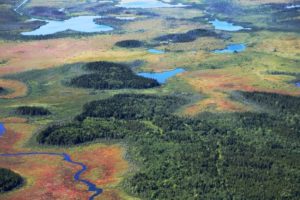Out of the public eye: Group looks at city council transparency
Researcher finds Fredericton meetings too often closed to public, but mayor suggests it can't be avoided
A citizens' group is flagging a transparency problem with municipal councils in New Brunswick.
More than half of Fredericton city council meetings are taking place behind closed doors, according to data from a little-known group calling itself Good Governance New Brunswick.
"There's a large period of time where the public and the media … are excluded from what government is doing," said Sandra Bender of Fredericton, identified as a researcher on the project and a founder of the group.
"And that means that we don't know what government is doing."
Lack of transparency makes it difficult to people to hold representatives accountable and to participate in decisions and could make it easier for corruption to creep in, Bender said.
"I wouldn't feel comfortable just sending my money over and saying, 'You go behind those doors and do what you think you need to do and then come back,'" she said.
"There's a high level of frustration and the trust is eroded. And that doesn't work well for either city council or for Frederictonians. So I think transparency is helpful for everybody."
A
graph put together by Sandra Bender or a group called Good Governance
New Brunswick shows how many hours Fredericton Council was open to the
public in blue and closed in red. (Submitted by Sandra Bender)
The data is based on official city records of open and closed minutes for council and council-in-committee meetings from 2018 through 2023, provided by the city clerk, said Bender.
It doesn't include committee meetings held on Thursday at noon, noted Fredericton Mayor Kate Rogers.
When those are considered the proportion of council business conducted in open session bumps up to well over two-thirds, she said.
Mayor defends council record on open meetings
Information is made available "at every opportunity" to the extent it is responsible, said Rogers.
"We stay every Monday after sometimes we will have had four or five hours of meetings. I stay afterwards to be in scrum to talk to journalists for anyone that would have any questions. I take calls, I take meetings, I go to schools and share information.
Fredericton
Mayor Kate Rogers says her council works to be as transparent at
possible to the public, and she personally tries to answer questions
from reporters and others. (Aidan Cox/CBC)
"We are trying to engage the public as much as possible in what we do with our civic governance. … If we can find more ways, we will do that. But we always have to be respectful of what is required to going to closed."
Many of the closed meetings are "council-in-committee" held twice a month prior to regular council meetings, Bender said in a release.
These meetings are meant to deal with operations of the municipality, but it's not clear what topics fall under that umbrella or why the discussions need to be kept from the public so frequently, she said.
Rogers said for some issues, council is required to meet in private.
"They're often personal information, information regarding contracts or relationships with other levels of government," said the mayor."
"It's delicate information that's being discussed and potentially could be jeopardized if we did them in open."
There are good reasons for dealing behind closed doors on occasion, Bender acknowledged — such as when discussing human resources issues, private information about employees, and matters of client-lawyer privilege or having to do with police investigations.
Eight such categories are defined in the Local Governance Act. The act requires that only a general topic and meeting date be recorded for meetings dealing with these matters.
But Bender feels that's too restrictive and said the recording of minutes should be permitted to allow for the possibility additional information may be made public after the fact.
Just because council is allowed to discuss something in private doesn't mean they always should, Bender added.
Open should be the default unless it's going to cause harm, she said.
How Ottawa manages to be more open
Bender cited Ottawa is a good example of a municipality that has put a lot of effort into being transparent.
Less than four per cent of Ottawa council meeting time over the same period was in private sessions.
One way that city keeps in camera meetings to a minimum is by having a group of senior managers and an integrity commissioner review agenda plans ahead of time, said Caitlin Salter-MacDonald, Ottawa's city clerk.
Operational staff are dedicated to making sure the only reports handled in private are those truly required to be, Salter-MacDonald wrote in an email.
 In
Ottawa, where a smaller proportion of meetings are closed to the
public, the senior managers and an integrity commission review plans to
make sure nothing is being unnecessarily kept from the public. (City of Ottawa)
In
Ottawa, where a smaller proportion of meetings are closed to the
public, the senior managers and an integrity commission review plans to
make sure nothing is being unnecessarily kept from the public. (City of Ottawa)
When something is done in private, there's either a designated date when the information can later be released or a reason documented about why the clerk and city solicitor think there is a legal reason not to, she said.
Ottawa also makes a lot of information available on its website, Open, Transparent and Accountable Government, including a lobbyist registry, open data, conflict-of-interest registry, memos issued to council, office expenses, executed contracts and reports.
The highest number of hours Ottawa council spent in closed-door meetings for any single year of the study was 12, said Bender.
That compares to a peak of 43 hours a year in Fredericton, she said.
No data from Moncton, Saint John
Documentation was also requested from Moncton and Saint John, said Bender.Saint John didn't respond, and Moncton declined.
 The City of Saint John says it wasn't aware of Bender's request for data on public meetings. (City of Saint John/YouTube)
The City of Saint John says it wasn't aware of Bender's request for data on public meetings. (City of Saint John/YouTube)
Asked by CBC News for an explanation and response, Saint John communications officer Erin White said: "The City is not aware of who this specific request was made to at the City, but we would be happy to provide the information if a formal request is submitted through the City's Clerks office."
Aloma Jardine, Moncton's manager of strategic communications, said staff couldn't find the request and asked for more details about who submitted it and when. Those details were not available at publication time.
Jardine noted Moncton has begun posting the dates and topics of private meetings.
The City of Moncton was also not able to find Bender's request for data. (Alexandre Silberman/CBC)
Good Governance New Brunswick was founded in 2020, said Bender. Partly, it grew out of her involvement in the community since 2018, including with provincial and municipal elections.
"This included experiences of women organizing to run more female-identified candidates for council seats."
Bender was recently involved in complaints against Fredericton council over the way the cross-town trail route was decided. That's only tangentially related to the transparency research, she said, and none of the other people who have taken issue with the trail route are involved in the Good Governance group.
Good Governance's goal is to provide information and advocate for good governance, transparency, public consultation and accountability, she said.
Bender said her personal background includes being a retired federal government worker who has worked with non-governmental organizations and non-profits, been a professional educator, volunteered in political campaigns and studied journalism.
She said she is the only member of the group in Fredericton, but a fluctuating number of other people are involved in research projects.
She did not respond to a request for more information about the other members, such as the approximate number, where they are located or their fields of expertise, but Bender described the group as independent and non-partisan.
The group decided not to have a social media presence or website so they could concentrate on research and avoid online toxicity and dysfunction, she said.
Another study related to transparency is partially complete, she said, and results may be shared if the group decides that would be worthwhile.
With files from Information Morning Saint John
CBC's Journalistic Standards and Practices
'Unfounded' complaint against politician cost City of Fredericton more than $18K
Some residents in Cassandra LeBlanc's ward felt a plan to connect the Cross-Town Trail bike and walking path was too dangerous
By John Chilibeck
Local Journalism Initiative Reporter, The Daily Gleaner
The City of Fredericton spent $18,776 on outside legal advice after a code of conduct complaint was lodged by more than a dozen people against their city councillor.
The figure was disclosed following a city council meeting Monday night by the municipality’s chief administrative officer, Steven Hart.
The complaint against Coun. Cassandra LeBlanc had been handed over to Joël Michaud, of the law firm Pink Larkin, who ultimately decided it was unfounded.
“It’s a long, complex complaint,” said Hart, who wouldn’t say who the complainants were or much about the complaint itself. “Our legal support team said it was unfounded.”
The complainants all live or work on the first block of Argyle Street near the downtown and across from the Atlantic Superstore, where a bike and walking trail is cut off by the roar of traffic on busy Smythe Street.
In a press release issued Aug. 14, the residents, including Mark D’Arcy, Caroline Lubbe-D’Arcy, Sandra Bender and Milda Titford, said they were upset with the city’s plans to connect the Cross-Town Trail bike and walking path.
While many of the residents want the trail extended, they don’t like the city’s plan, which they consider too dangerous. They argue the new portions of the trail would cross too many busy driveways and roadways, a threat to the health and safety of pedestrians and cyclists, particularly unwary children. And they point out it wouldn’t be to the same standard of the more than 70 kilometres of existing trails in the city.
 The City of Fredericton has released a conceptual plan to
complete the Cross Town Trail, a generational project that will connect
its multi-use trail network city-wide. - Facebook / City of Fredericton
The City of Fredericton has released a conceptual plan to
complete the Cross Town Trail, a generational project that will connect
its multi-use trail network city-wide. - Facebook / City of Fredericton
They said they gave ample warning to LeBlanc, their ward representative, that the plan was unsafe, but she failed to speak up and represent them around the council table.
“Individual councillors, especially ward councillors, are certainly bound to exercise a duty of care and speak up about the public safety and health of their respective ward constituents,” D’Arcy said in the release.
Titford and Bender argued the complaint process was rigged against citizens.
“The City of Fredericton selects the investigator and pays for their services, instead of following basic best practice of using a truly impartial and independent party that all parties can trust like an integrity commissioner,” said Bender, who added that 218 days to complete the review process was far too long.
Although the residents had issued the press release nearly two weeks ago, Hart explained that the municipality guarantees the anonymity of such complainants so people can feel comfortable as whistleblowers.
It’s the third time since the present council was elected in 2021 such a review has produced an unfounded result, and the second time involving the same councillor, LeBlanc, who declined interview requests.The tab of the complaints reviewed by outside law firms is now close to $42,000, Hart said.
The report to council said the complaints were filed in December, and that Mayor Kate Rogers and the city clerk met with the complainants March 1 as part of the informal dispute resolution process. Afterwards, the mayor determined the code of conduct complaint should go to an outside law firm.
On Monday night, council accepted the findings in the report without comment. The mayor declined an interview request
Even the number of complainants is in dispute. The city says it received 13 complaints, but the group said there were 14 complainants.
https://www.uff.ca/touchstone/2019-11.pdf
Women’s Potluck Gathering
The next Unitarian Fellowship women’s potluck will be
held Friday, November 22nd, 2019. Sandra Bender will
host the gathering at her home. We will gather at 6 PM
and eat at 6:30 PM. Further information about location,
parking, and topic for the evening will be circulated by
email. For further information, contact Joan Brewer at
jebrewer@rogers.com
https://cpawsnb.org/category/campaigns/forestcampaigns/
Connecting Nature across the Chignecto Isthmus
By: Sandra Bender
I am 23 kilometers long with two coastlines. In addition to being a very important transportation link, I am recognized regionally, nationally, and internationally as a vital wildlife corridor. Indeed, I provide the only route for terrestrial wildlife to move in and out of Nova Scotia. Who am I?

Let me give you some additional details about myself. I am a narrow strip of land that joins Nova Scotia to New Brunswick and the rest of the continent. I have two distinct coasts – to the northeast is the Northumberland Strait and on southwest is the Bay of Fundy. I host the towns of Amherst, NS and Sackville, NB, the Trans-Canada Highway and an inter-provincial railway crossing. I am the Chignecto Isthmus, and ecosystem connectivity is vital to my health and prosperity.
Ecosystem connectivity refers to the ability of plants or animals to move through a landscape. Connected ecosystems maintain suitable habitats and allow my flora and fauna to move about as they need to survive and thrive. Greater connectivity across my ecosystem means fewer barriers to the small movements or grand migration of species. When people plan for connectivity in my ecosystem, regional biodiversity is protected as neighbouring ecosystems are linked. Without connected ecosystems, Nova Scotia could become an ecological island, isolated from New Brunswick and mainland North America. This could reduce the opportunity for migration and dispersal of terrestrial wildlife between the provinces.

I am home to many species including black bear, moose, fisher, lynx, coyote, red fox, osprey, bald eagle, eastern white cedar, black ash, skunk cabbage and a number of rare or uncommon species, including 56 species of birds and 101 species of plants. Many of the wildlife living here need to move about to forage, nest, and reproduce.
When ecosystems are connected, sometimes through natural or human-made movement corridors, links between habitats allow these and other species to access the resources they need to survive. This is especially important for species that are heavily impacted by habitat fragmentation, when human activities such as residential development, road construction, agriculture, and intensive forestry separate habitats. Sadly, all of these activities take place at a significant rate on the Isthmus, resulting in an increasingly fragmented ecosystem.

As New Brunswick and Nova Scotia develop infrastructure, the impacts of climate change will be felt across the Isthmus if connectivity isn’t protected. Restricting movement and decreasing ecological connectivity could pose risks for wildlife, and will likely limit the ability of plants and animals to adapt to climate change.
CPAWS NB and CPAWS NS want to see me as healthy as possible by establishing and improving my connectivity. They have worked with each other, as well as local residents and researchers, to identify opportunities for greater connectivity across my area. This is collaboration for connectivity. If you ask me, I don’t think one can happen without the other.
Thankfully, my humans get it. What encourages me most is the wide range of people involved in the efforts to keep my many species and habitats thriving. Land trust organizations active on the Isthmus including our friends at Ducks Unlimited Canada, the Nature Conservancy of Canada, and the NB Community Land Trust have worked with landowners and governments to protect me.

Local residents, hunters, trappers, landowners, and conservationists helped to identify and provide feedback on areas that are important to wildlife movement. They also provided valuable information on changes and risks to this movement. For example, community members have suggested that connectivity conservation efforts should focus along the northern portion of Highway 16 in New Brunswick to create a wildlife “movement funnel” across the Isthmus. This area represents some of the largest patches of habitat in the NB-NS border area and is critical to any projected connectivity route. So many people working together in my best interest is heartening!
Without greater protection it will be much harder for species to withstand the pressures of habitat destruction and fragmentation, increased competition for limited resources, and other stressors. All of these factors create isolated “islands” that affect wildlife’s ability to survive. Protecting wilderness within connected ecosystems is critical. This is why CPAWS NB is calling for more protected areas in New Brunswick, and more protected areas that are ecologically effective and strategically placed to allow for ecosystem connectivity that supports our local wildlife.
We know that nature and wildlife are important to New Brunswickers. Add your voice to our e-letter campaign and tell your MLA that protecting nature in New Brunswick is important to you!
References
MacDonald, A. & Clowater, R. (2007). Natural Ecosystem Connectivity Across the Chignecto Isthmus – Challenges and Opportunities. A collaborative project of CPAWS New Brunswick and CPAWS Nova Scotia. Retrieved November 5, 2018: https://www.cpawsnb.org/wp-content/uploads/2017/12/ChignectoFinalVersionJune06v2.pdf
Nature Conservancy Canada. (2018). Moose Sex Project (Chignecto Isthmus).
Retrieved November 5, 2018: http://www.natureconservancy.ca/en/where-we-work/nova-scotia/featured-projects/Chignecto-Isthmus.html
Conservation Corridor. (2018). Corridors in Conservation. Retrieved November 5, 2018: http://conservationcorridor.org/corridors-in-conservation/
Header photo by Julie Reimer


No comments:
Post a Comment